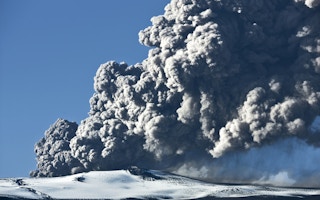Scientists think they know, in principle, how to tame hurricanes and reduce storm surge risks.
All it would take would be a stratosphere full of sulphate aerosols sufficient to dim the sun, lower tropic ocean temperatures and reduce the hazard of the kind of windstorm that hit New York in 2012 and New Orleans in 2005, with devastating consequences.
Hurricanes are likely to impose increasing costs as the planet’s climate changes. However, there is a little more to the solution than a simple darkening of the upper skies.
The quantities of sulphate discharge needed to make a difference would be the equivalent of the catastrophic Mount Pinatubo volcanic eruption that scorched the Philippines in 1991. And there could also be other unwelcome consequences.
Test of hypothesis
Polar scientist John Moore, now at Beijing Normal University, and colleagues report in the Proceedings of the National Academy of Sciences that their exercise was a test of a hypothesis: a “qualitative indication” that geoengineering could help reduce hurricanes.
Co-author Ben Kravitz, a climate scientist at the Pacific Northwest National Laboratory in the US, says: “We’re looking at possibilities now, in case the world needs these options down the road.”
As humans continue to burn fossil fuels, so levels of greenhouse gases will build up in the lower atmosphere, global average temperatures will rise, and heatwaves, floods and windstorms could become more frequent, more intense, or both.
So the hurricane-suppressing scientists worked entirely from climate simulations to see if eruptions could in fact calm some of the weather extremes predicted under climate change.
Although climate scientists have repeatedly said that only a sharp reduction in carbon dioxide emissions will have any impact in the long run, a number of groups have tested the other possible answer: the considered and wilful alteration of the planet’s climate through geoengineering.
The results so far have been mixed, or downright unpromising. Scientists have looked at the idea of “whitening” the Arctic to prevent the loss of ice; they have explored the idea of tapping energy from the oceans to reduce global temperatures; and they have confirmed that sulphate aerosol discharges could severely disrupt world rainfall patterns and make things worse for millions.
There is evidence that the technique could offer temporary relief for coral reefs – also at risk from warming oceans – but overall, researchers have repeatedly pronounced geoengineering to be unworkable.
The limited case of hurricane control, however, suggests that it might be effective − if expensive.
To mimic the effect of a Pinatubo-type eruption, researchers would have to lift to airliner altitudes roughly a quarter of all the sulphates produced by human industry in any one year.
In the lower atmosphere, these cause respiratory illnesses. At altitude, these could lower the global temperature by about half a degree Celsius, for a year or two.
But they could also affect the monsoon rain system that nourishes hundreds of millions in Asia, and they could damage the ozone layer that screens most humans from harmful ultraviolet radiation.
Over time, it would reduce sea surface temperatures and reduce the probability of Katrina-scale hurricanes and devastating storm surges of the kind that swept through New York and New Orleans in the company of the hurricane-force winds.
Benefits and risks
But that wouldn’t mean it was a safe option. “This is a narrow study,” Dr Kravitz says. “Geoengineering researchers have to very carefully categorise the other benefits and risks, and hand off that information to the decision makers.”
Coincidentally, another study in the PNAS journal confirms that real volcanic eruptions could, if they happened in the summertime, not only cool the northern hemisphere, but also possibly generate an El Niño pattern in the Pacific and even have an impact on ocean currents in the Atlantic.
Since El Niño is linked to devastating floods on the west coast of the Americas, and drought and fires in the Indonesian rainforests, and since the Atlantic currents are an integral part of the European climate machinery, the consequences might go far beyond hurricane control.








